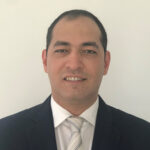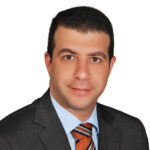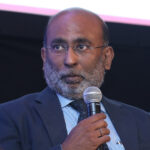A close look at how incorporating disinfection strategies and giving specialised attention to coils, ducts, filters, heat recovery wheels and other building essentials can positively contribute to the fight against the spread of COVID-19. Insights from the plenary discussion held during the Disinfection 360 webinar, organised by CPI Industry…
The cost of being complacent in the time of COVID-19 is human life. This is the grim reality the global community has come to terms with over the past few months – one that has forced stakeholders in the built-environment to be even more vigilant when it comes to rolling out measures aimed at ensuring occupant health and wellbeing.

Ahmed Elkiki
Ahmed Elkiki, Director of Technical Services, RAK Hospitality, Government of Ras Al Khaimah, UAE, is one such building professional. Gleaning from his experience in the hospitality sector, Elkiki underscored the need to double down on preventive measures. “The first thing hotel owners should be doing, whenever they reopen, is disinfecting surfaces,” he said. Although there are several methods available in the market, Elkiki observed that the trend is moving in the direction of utilising disinfection gates and thermal cameras upon entry. “However, if you test someone’s temperature but they are not symptomatic and they enter the building — you have the virus in your building,” he said. “If someone comes with a mask, spraying his skin with chemicals will not really help you, because the virus is still in his respiratory system, and he will still be inside your building.”
With the wide array of commercial products available in the market, Elkiki added that there is also a need to be judicious when choosing disinfection systems. “A lot of companies introduce municipality-approved chemicals to owners, but they don’t say what they are approved for,” he said. “They are typically approved for B2B purposes, they are not approved to be sprayed on people and they are not approved for certain applications. So, the approval they present, it’s not always showing what application it can be used for.” Elkiki said that that it is the responsibility of the hotel operator to understand usage and operation of chemicals to ensure proper disinfection of spaces.

Hanan Ahmed
The need to have a firm grasp on disinfection measures especially rings true for Hanan Ahmed, Head of Engineering & Maintenance Services, Al Baraha Hospital, UAE, who emphasised that all precautions must be taken during these unprecedented times. Ahmed said that although the World Health Organisation (WHO) issued a statement that SARS-CoV-2 was not airborne, there is still a need to disinfect, because droplets can fall to the floor, adding that this has prompted hospital staff to disinfect all equipment used and to clean around patients thoroughly.
Ahmad added that Al Baraha is giving special attention to improving operation of the hospital from an engineering perspective. Prior to COVID-19, she said, the hospital had already taken stringent measures to enhance air quality to prevent the spread of infectious diseases, by cleaning the coils, systems and ducts semi-annually. However, after COVID-19, efforts were intensified, and the team had undertaken greater precaution and initiated more disinfection measures to prevent staff from getting infected. “The patient already has COVID,” she said. “We have to protect our front liners – the doctors, nurses and workers, everybody, including our administrative staff, because they are the ones in this scary environment.”
An important strategy the hospital implemented, Ahmad said, relates to fresh air changes. She explained that while areas such as the critical care department, ICU and neonatal room would typically have more fresh air changes, post-Covid-19 the hospital has made an effort to transfer all wards to negative pressure before receiving any new patients. “We are not allowing any return air to come back to the hospital,” she said “We isolate all the departments, and we make all the air go outside, with pre filter, HEPA filter and UV light to prevent returning infected air. From the beginning, we take this action, and although it is very costly and it is affecting our temperatures and humidity, I feel the action that has been taken is right.”

Imran Shaikh
Agreeing, Imran Shaikh, Vice Chair, CIBSE, UAE, said that given the current scenario with COVID-19, increasing fresh air supply, even to levels that exceed typical CIBSE and ASHRAE recommendations, is good practice. “To minimise airborne transition of SARS-CoV-2, the general advice is to increase the air supply and the exhaust ventilation,” he said. “The underlying principle is to dilute and exhaust them to outside air, and reduce a chance they are becoming deposits on surfaces and inhaled by new users.” Shaikh said that the risk of room occupants catching illness is reduced when they are in a well-ventilated room than in a poorly ventilated one, thus underscoring the need to increase fresh air in a manner that, hopefully, doesn’t have too much of an impact on energy efficiency.
Falling short of the basics

Azmi S Aboul-Hoda
For Azmi S Aboul-Hoda, Managing Director, EMergy, UAE, although additional measures to improve IAQ are commendable, he said that stakeholders should take the time to reflect whether basic operational requirements of the building are being met in the first place. “I would like to suggest to work with what we have,” he said. “We already have buildings equipped with the basics that we can work with. If we really utilise what we have in a building properly, then we are moving one step ahead. The next step is extra measures that will enhance our situation. However, I don’t really suggest to go ahead and spend money on extra measures, while already our components and systems and what we have in building are not utilised in the direction of ensuring right air quality and preventing the spread of COVID-19.”

Kandasamy Anbalagan
Kandasamy Anbalagan, Managing Partner, Proleed Engineering Consultants, UAE, agreeing, pointed out that Dubai Municipality guidelines and building permit requirements ensure that all relevant systems should be in place in most residential and commercial buildings, including critical applications, such as hospitals and hospitality sector. Even pre-COVID, he added, what has been installed, as part of design requirements, should provide fresh air, filtration, air treatment and energy recovery, according to ASHRAE standards. “Whether FM had the knowledge or was aware of their purpose when the building was handed over – this is where disconnect comes,” he said. “They don’t know the impact of what they do on the building’s indoor air quality.”
Anbalagan said that in many instances, in order to save energy the FM team has switched off the fresh air or kept the temperature at 24-25 degrees C. “They are bringing moisture into the building, and it’s going to remain in the building forever unless treated and brought back to design conditions at 15-16 degrees C,” he said. Unfortunately, Anbalagan said, this is an issue that permeates across residential and commercial facilities, such as shopping malls.

Mohamed R Zackariah
Echoing similar observations, Mohamed R Zackariah, Chief Consultant, Suhaimi Design– Protecooling, Saudi Arabia, added that poor utilisation of existing equipment could also be attributed to inadequate commissioning. “The commissioning process is a quality assurance process to ensure whatever is being implemented and constructed and designed is properly executed at site and properly commissioned, properly put in operation and properly kept in operation continuously,” he said. “This commissioning process has a role in the pre-design stage, in the design stage, in the project handover stage and while FM is taking over the project.”
Ideally, Zackariah said, there should be a properly trained FM team and an ongoing commissioning process to ensure all equipment, systems and subsystems are up and running in an optimum way. “But, practically, most of the requirements are not properly fulfilled,” he said. “There is lack of expertise in the construction side and lack of expertise in the FM side that renders even the existing system, which has capability to provide benefits, useless because they are not operated and maintained well.”
Zachariah said that a classical example is control systems. “There are high quality control systems executed and implemented in projects,” he said. “When you go and inspect a building, you will see most of the operation are bypassed and operating on manual mode. Basically, if we make all what we have up and running in good operating condition, we will be better off than where we currently are.”

Mohamed Shafiq Ur Rahman
Weighing in, Mohamed Shafiq Ur Rahman, Senior HVAC Engineer 1, Dar Gulf Consult, Kuwait, shared the same experience even in critical high-density developments. “My experience in different projects is that we design it in a very good manner, following all regulations and guidelines given by relevant authorities and industry bodies, such as ASHRAE and CIBSE,” he said. “After we do the installation, our team members tell us that operations and maintenance has been neglected in a very bad manner.” Rahman said this typically manifests in filters not being properly maintained and replaced or ducts not being cleaned. “Most of the people neglect these basic aspects,” he said. “We are not getting required design intent, and operating rules are being flouted, and that’s why we don’t have IAQ. Whatever chemicals and disinfection you use, if the system recirculates contaminated air pollutants you end up nowhere. This is what is happening in most of the projects. As designers, we design to the best of our ability by following guidelines, but if it is not implemented after installation and not properly operated and maintained, whatever we have done is lost.”
Anbalagan said he believes a lot of the gaps happen, because the FM personnel are not liable to authorities or to the building owner when it comes to IAQ-related operations and proper preventive maintenance of systems. As of today, he said, there are no clear regulations or directions from the Municipality regarding HVAC-related maintenance, meaning operators are not held accountable. “Projects and buildings being designed are not being maintained,” he said. “There has to be some kind of regulation – that’s the only way you can bring in a change.”
The fulcrum

Dominic Mc Polin
For Dominic Mc Polin, regulation is the fulcrum in the seesaw balancing energy-efficiency requirements and public health concerns. In his position as Chief, Central Planning, Central Planning Office, Ministry of Works, Municipalities Affairs and Urban Planning, Bahrain, Mc Polin said that the Ministry is looking to readjust energy targets in order to balance energy-efficiency goals with public health issues. “Energy audits must also include the public health audit – it’s as simple as that,” he said. “It has to be put into the green building codes – that’s the vehicle in Bahrain.”
Mc Polin said the Ministry has undertaken operational consultancy to look into the adjustments required to strike this balance and initiating energy modelling in Bahrain to look at the additional cost that will be incurred if fresh air flushing is initiated in buildings in the morning before occupation, and if the systems are running 24/7 with fresh air intakes. “We are looking at the increase in energy demand,” he said. “And what we are trying to do is to articulate this into our green building codes, so our energy auditing now will include, we hope, a public health audit on the environment, based on good science and emerging science.”
Mc Polin admitted that it is very hard to take additional costs at this time. “Whether you are in a private sector or in the public sector, we are all facing financial restrictions, and it’s very difficult when you come forward and say, ‘Well, we have to increase our energy cost here in order for public health benefit.’ That’s where we are at the moment, and we have opened these discussions with key ministries, and we are hoping to make those adjustments to our green building codes.”
Despite the cost and challenges, Mc Polin said that industry stakeholders must seriously look at strategies related to recirculation of air owing to the the threat of fake news. “All that has to happen is for fake news to get out that ACs give you COVID, and your shops are bankrupt and you can’t sell apartments anymore,” he warned. “I know people moving out of apartments. Why? Because they are insecure, they don’t know who is in the lift, or in the corridors, and they don’t know what air they are breathing. If we are not smart enough to deal with these problems up front, even if we don’t have the full scientific formula, this will be a major threat to our real estate industry in the type of apartments we build, in the type of shopping malls and in the type of public spaces.”
Mc Polin warned that once fake news catches on, “every developer who doesn’t want to pay the price for fresh air flushing will be bankrupt”. “The smartest developers I have spoken to are already implementing this in their buildings,” he said. “Why? Because when fake news hits the ground, they want to put their hand up and say: ‘Hey, guys! We knew about this, and we have taken these actions, and we are doing this and that.’ That’s what’s going to separate the bankrupt from the survivors in the next wave – and the next wave is a recession. It’s going to articulate itself in the herd instinct, just like in the stock exchange. It doesn’t matter what the logic is or what the numbers are, the herd will decide what will happen, and if fake news gets out that, there is a problem with ACs and air circulation, every developer that has not paid attention to these messages will go bankrupt.”
Copyright © 2006-2025 - CPI Industry. All rights reserved.